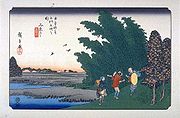
Mieji-juku
Encyclopedia

69 Stations of the Nakasendo
The are the rest areas along the Nakasendō, which ran from Nihonbashi in Edo to Sanjō Ōhashi in Kyoto. The route stretched approximately and was an alternate trade route to the Tōkaidō.-Stations of the Nakasendō:...
of the Nakasendō
Nakasendo
The , also called the , was one of the five routes of the Edo period, and one of the two that connected Edo to Kyoto in Japan. There were 69 stations between Edo and Kyoto, crossing through Musashi, Kōzuke, Shinano, Mino and Ōmi provinces...
. It is located in the present-day city of Mizuho
Mizuho, Gifu
is a city located in Gifu Prefecture, Japan.As of July 2011, the city has an estimated population of 52,269, with the number of households being 19,567...
, Gifu Prefecture
Gifu Prefecture
is a prefecture located in the Chūbu region of central Japan. Its capital is the city of Gifu.Located in the center of Japan, it has long played an important part as the crossroads of Japan, connecting the east to the west through such routes as the Nakasendō...
, Japan
Japan
Japan is an island nation in East Asia. Located in the Pacific Ocean, it lies to the east of the Sea of Japan, China, North Korea, South Korea and Russia, stretching from the Sea of Okhotsk in the north to the East China Sea and Taiwan in the south...
. This post town received its name from Mie-ji
Mie-ji
is a Buddhist temple of the Tendai sect located in Gifu, Gifu Prefecture, Japan. It is also referred to as Mie-ji Kannon . It is one of the Mino Thirty-three Kannon...
, a temple which was located in Mizuho during the Edo period
Edo period
The , or , is a division of Japanese history which was ruled by the shoguns of the Tokugawa family, running from 1603 to 1868. The political entity of this period was the Tokugawa shogunate....
. Saitō Dōsan
Saito Dosan
was a daimyo who dramatically rose and also fell from power in Sengoku period Japan. He was also known as the for his ruthless tactics.-Life:Originally a wealthy merchant from Yamashiro Province , he entered the service of Nagai Nagahiro of Mino Province , assuming the name Nishimura Kankurô.He...
, during his reign of power, moved the entire temple to the present-day city of Gifu
Gifu, Gifu
is a city located in the south-central portion of Gifu Prefecture, Japan, and serves as the prefectural capital. The city has played an important role in Japan's history because of its location in the middle of the country. During the Sengoku period, various warlords, including Oda Nobunaga, used...
.
Surrounding Area
The Goroku RiverGoroku River
The is a river in Japan which flows through Gifu Prefecture. It empties into the Sai River, which is part of the Nagara River system. The river, whose name means "56", was named after Mieji-juku, the 56th post town on the Nakasendō, a historical trading route....
, which ran alongside Mieji-juku, received its name from the post town. "Goroku" (五六) means "56." (Mieji-juku was the 56th stop along the Nakasendō if Nihonbashi
Nihonbashi
, or Nihombashi, is a business district of Chūō, Tokyo, Japan which grew up around the bridge of the same name which has linked two sides of the Nihonbashi River at this site since the 17th century. The first wooden bridge was completed in 1603, and the current bridge made of stone dates from 1911...
is included.)
Neighboring Post Towns
Nakasendō- Gōdo-jukuGodo-jukuwas the fifty-fourth of the sixty-nine stations of the Nakasendō. It is located in the present-day city of Gifu, Gifu Prefecture, Japan...
- Mieji-juku - Akasaka-jukuAkasaka-juku (Nakasendo)was the fifty-sixth of the sixty-nine stations of the Nakasendō. It is located in the present-day city of Ōgaki, Gifu Prefecture, Japan. It flourished during the Edo Period, as it was located in a fertile valley, next to a river.-Modern Day:...

